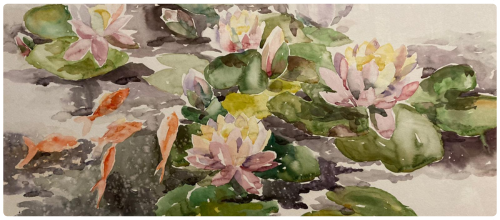We are inviting you to Sigita Grabliauskaitė’s personal watercolour exhibition, “Moods of Plein Air” on the second floor of the library.
Sigita Grabliauskaitė – glass artist, member of the Lithuanian Artists’ Union since 1999, granted the status of Art Creator in 2005, long-time lecturer at the Academy of Arts of Kaunas College of Arts and Education, coordinator of the Object Art Programme, and participant in many national and international exhibitions. The artist graduated from the Faculty of Fine Arts of Vilnius Academy of Arts in Kaunas with a degree in artistic glass and teaches the secrets of glassmaking to her students. Thus, glass art is the main field of her work. Briefly introducing Sigita Grabliauskaitė’s glass works, it should be mentioned that the artist is particularly fond of creating in cycles, which become memorable for the viewer and vividly present the artist in exhibitions, catalogues, and press. The artist’s oeuvre includes a number of famous series of glass posters and sculptures that have shaped her personal style, including, without a doubt, the themes of signs, masks, flowers, crystallisation, angels, horses, artists’ faces, old architecture, and others. Here, the artist’s variety of plastic principles and techniques are reflected: graphic, painterly, and sculptural expressions characteristic of one or another cycle are developed, expressive colour vibrations are developed, or a semantic graphic language is used. Depending on the prevailing need to express colour, form, or line in glass works, the aesthetics and professional quality of the glass techniques used (casting, sintering, grinding, polishing, engraving, stained glass, etc.) are also reflected in the glass works.
Some of her works remind the viewer of primitive rock marks, others of an abstract pictorial vision of an image or the Art Nouveau movement. In 2008, the artist launched the Sleepers in Time series, which was a kind of performance: during a plein-air session, the artist “removed” plaster casts from her models—friends and colleagues—which she later embodied in glass sculptures. Here, the frozen images immortalised in the glass material took on a completely different portrait expression, showed unexpected facial expressions, and revealed personality traits of people that they did not expect to have. This cycle of glass sculptures continues today. In recent years, the artist has also developed an interest in the theme of women. This theme, which is often discussed by artists, is conveyed in a very graceful way in the sculptural glass relief in the work of S. Grabliauskaitė. However, over the years, Sigita Grabliauskaitė has been creating more than just art glass works; she often participates in various watercolour plein-air workshops, casts watercolours, and paints. She joined the LDS Watercolour Section in 2006, taking part in the “Nemunas” plein-air workshop in Šetenius, at the homestead of Česlovas Miloš. After becoming interested in the mysteries of watercolour technique, she became actively involved in the activities of the section. She took part in all the plein-air workshops organised by the Section, as well as in exhibitions of watercolour artists.
Introducing her interest in watercolours, the artist says that she finds it interesting to compare the creation of a colourful glass plaque in the heat of a fire with the pouring of colour in water, which is produced in watercolours. According to the artist, glass art and watercolours are also linked by the transparency that is created by the interaction of colour with fire in glass and colour with water in watercolours.
The watercolours in this exhibition are dominated by natural motifs and landscapes: lily blossoms, sunny and rainy moods of the Dubysa River, the banks of the Nemunas River, the seaside, the Sventybrascis, fragments of Česlovas Miloš’s homestead, moody sketches of the Zyplių Manor, and other images of the nature of his native Lithuania. There is a sense of freedom of touch and expression, as well as a tendency to generalise the motif and improvise. The moods that prevailed in different plein air paintings are reflected in the background of the author’s works; in some places it is light, painted on white paper, with light touches of light colour creating the desired motif. Elsewhere, the background is dark. Then the whole painting requires a brighter, more expressive colour treatment that balances the background—a deeper, slightly more dramatic artistic solution.
Prof. Dr. . Raimonda Simanaitienė
2024.03.05
Video of the exhibition.

